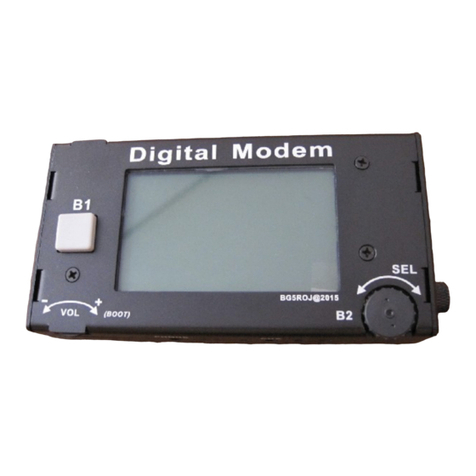
If you notice that either meter jumps upwards when you key the transmitter and drops down again your keying the
transmitter may be causing either an electronic click” or mechanical clunk”, de-sensing” the transmitter's ALC.
This can be caused by the the powering-up of the electret element in the microphone when the radio is keyed and/or
by the (noisy!) mechanical action of the switch – but the result can be the same in either case: A temporary desense”
when you start talking and/or an annoying sound heard by the station receiving you!
To minimize this adjust menu item “TX Mute De ay” which will keep the microphone audio muted for a short period
after keying up. The parameters are adjustable from 0 (off) to 25, which keeps the audio muted for a full 250
milliseconds (one-quarter of a second) after the microphone is keyed.
It is recommended that one finds the minimum value to reliably suppress the appearance of the microphone key-up
noise and then increase it by 50%.
If this does not work, it may be that your microphone is taking too long to power up”. In this case disconnect the end
of R8 that connects to U1 and, instead, connect it to the 3.3 volt supply at C10-C13.
Using the mcHF with computer “Sound Card” modes via the Line-Input and Line-
Output connections:
The mcHF may be connected to a computer, tablet or smart phone via audio cables and the PTT line on the
Microphone cable to allow modes such as SSTV, PSK31, WSPR or other digital Sound Card” mode. To do this,
configure the transceiver as follows:
•Using button G1, select USB mode: All digital modes are operated using USB, regardless of band. In this
way the audio frequency of the digital signal may be added to the frequency display to calculate the actual
transmit/receive frequency.
•Set RIT to zero using ENC3: Press button M3 as necessary to highlight RIT to allow adjustment. When
using a digital mode the RIT MUST be disabled or else you will have difficulty making contacts!
•Set CMP to zero using ENC1: Press button M1 as necessary to highlight CMP to allow adjustment. When
using a digital mode, the audio compressor must be set to MINIMUM or else it may degrade the digital
signal!
•Before connecting the external device (Computer, tablet, phone) set the audio output level to mid-scale. Also
set the audio input gain to approximately mid-scale as well.
•For receive, one may use any of the available receive audio filters, but it is recommended that the 10 kHz
filter not be used! If narrow (300Hz, 500Hz or 1.8 kHz) filters are used, one may shift the center frequency
of that filter in the menu to suit the passband for that mode, but be aware that it is possible to run too narro
a filter for some of the wider” digital modes! In the vast majority of cases the 2.3kHz filter will be adequate.
Connect the Line-Input jack (J2) of the mcHF to the audio output of the device you are using to generate the audio and
connect the Line-Output jack (J1) of the mcHF to the audio input of that same device.
To key the transceiver, you will need also to connect a cable the Microphone jack (J3 on the UI board) or the Key
jack (J2 on the RF board) and the PTT/Key line on either of those jacks (the “ring”) would be grounded to key the
transceiver: Typical rig-computer interfaces will easily accommodate this connection.
•Preferably, connect the mcHF transceiver to a 50 ohm dummy load capable of handling at least 10 watts.
Alternatively, you may tune to a c ear frequency while connected to an antenna with a kno n-good 50 ohm
match.
•Using button M3, select LIN mode. You may need to press-and-hold this button to change from MIC to
LIN. Press button M3 as necessary to highlight LIN.
•Using button F2 select the AUDio meter.
•Using button G3 set the mcHF to 0.5 watts for this setup.
•Using the program running on the external device, key the computer using the selected mode. If the program

























